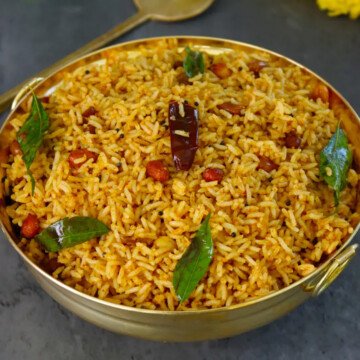
Puliyodarai – Tamarind Rice
Puliyodarai, or Tamarind Rice, is a tangy South Indian dish made with rice mixed with a spicy tamarind paste, seasoned with mustard seeds, fenugreek, and curry leaves. Often garnished with peanuts, it’s known for its sour and spicy flavor, making it a popular choice for picnics and travel.
Ingredients
For the Tamarind Paste:
- 1 Lemon-sized ball of tamarind
- 1 ½ Cup Water (for soaking tamarind)
- 2 tablespoon Sesame oil (gingelly oil)
- 1 teaspoon Mustard seeds
- 1 tablespoon Chana dal (split Bengal gram)
- 1 tablespoon Urad dal (split black gram)
- 3 Dried red chilies, broken
- A pinch of asafoetida (hing)
- 10-12 Curry leaves
- 1 teaspoon Turmeric powder
- 2 teaspoon Red chili powder
- 2 teaspoon Coriander powder
- Salt to taste
- 1 tablespoon Jaggery (optional)
For the Rice:
- 1 ½ Cup Raw rice (Basmati or Sona Masoori)
- 2 ½ Cup Water (to cook rice)
- 1 tablespoon Sesame oil (to prevent sticking)
- Salt to taste
For Garnishing:
- 2 tablespoon Roasted peanuts
- 2 tablespoon Roasted cashews (optional)
Instructions
Cooking the Rice
- First, rinse the rice thoroughly until the water runs clear to remove excess starch. This helps achieve that fluffy, non-sticky texture.
- Next, soak the rice for 15-20 minutes before cooking to ensure the grains cook evenly. If you’re using a rice cooker, follow the water-to-rice ratio (generally 1:1.5).
- Importantly, don’t stir the rice too much while it’s cooking to avoid breaking the grains. When it’s done, let it rest for 5 minutes to set.
Preparing the Tamarind Paste
- To begin with, soak a small lemon-sized ball of tamarind in warm water for 15 minutes. Afterward, extract the juice by pressing the tamarind.
- If, after tasting, the paste seems too bitter, simply add a pinch of jaggery or sugar to balance the flavors.
- Consequently, the tamarind paste should be tangy but not overwhelming, setting the perfect foundation for the dish.
Making the Puliyodharai Masala
- Firstly, dry roast coriander seeds, chana dal, and urad dal in a pan until golden and aromatic.
- Then, grind the roasted ingredients into a smooth powder using a blender or spice grinder. This masala will form the rich base of the dish.
- Not only does this masala bring a depth of flavor, but it also gives the Puliyodharai that unique earthy richness.
The Perfect Tadka
- Now, heat oil in a pan and add mustard seeds. Wait for them to pop, then toss in dried red chilies and curry leaves.
- Following this, add a pinch of asafoetida (hing) for an extra layer of fragrance. This creates the aromatic tempering or tadka.
- Finally, pour this hot, spiced tempering over the cooked rice, letting it infuse the grains with all the bold, flavorful aromas.
Notes
Regional Variations of Puliyodharai
-
- Tamil Nadu Style: Classic and tangy with a subtle sweetness from jaggery, this version uses seco rice to create a dense, hearty texture. Perfect for those who enjoy a balanced dish that’s both satisfying and flavorful. Additionally, the richness of tamarind shines through, offering an authentic taste of Tamil Nadu.
-
- Karnataka Style: Richer and more aromatic, this variation incorporates grated coconut or ghee, adding both creaminess and depth. Further more, the coconut enhances the dish, giving it a unique, tropical twist compared to other regional styles. In essence, it’s a slightly indulgent take on the classic puliyodharai.
-
- Andhra Style: Bold and fiery! Extra chili, peanuts, and ginger kick up the spice level, making it the go-to version for those who crave a stronger, more intense flavor. Thus, this style stands out for its robust heat and nutty crunch, ensuring a satisfying meal for spice lovers.
-
- Telangana Style: Crunchy and flavorful, this version includes fryum (papad) and lentils, along with a burst of curry leaves. The mix of textures and flavors creates a dynamic dish that’s both crunchy and aromatic, delivering a satisfying crunch in every bite. Moreover, this style is often enjoyed with a side of lentils, adding extra nutrition and taste.
Tips & Tricks for Making Perfect Puliyodharai
1. Consistency of Masala: Cook the tamarind masala long enough to thicken, but don’t burn it! Timing is key for that perfect, flavorful balance. 2. Perfect Rice Texture: To avoid mushy rice, let the rice cool slightly before mixing it with tamarind paste. This helps keep the rice fluffy and prevents it from becoming clumpy! 3. Adjusting the Tanginess: Control the tamarind by adding more or less to suit your taste. Balance the sourness with a pinch of sugar or jaggery to make it just right! 4. Spice Level: Control the heat by adjusting chili powder. For a milder version, you can add coconut or yogurt to cool things down.Nutrition
Nutrition Facts
Puliyodarai – Tamarind Rice
Amount per Serving
Calories
1364
% Daily Value*
Fat
68
g
105
%
Saturated Fat
11
g
69
%
Polyunsaturated Fat
16
g
Monounsaturated Fat
14
g
Sodium
10
mg
0
%
Potassium
450
mg
13
%
Carbohydrates
124
g
41
%
Fiber
14
g
58
%
Sugar
17
g
19
%
Protein
24
g
48
%
Vitamin B1
0.2
mg
13
%
Vitamin B2
0.1
mg
6
%
Vitamin B3
2
mg
10
%
Vitamin B5
0.5
mg
5
%
Vitamin B6
0.3
mg
15
%
Vitamin C
5
mg
6
%
Vitamin E
1
mg
7
%
Vitamin K
2
µg
2
%
Calcium
183
mg
18
%
Iron
4
mg
22
%
* Percent Daily Values are based on a 2000 calorie diet.
Tried this recipe?Let us know how it was!